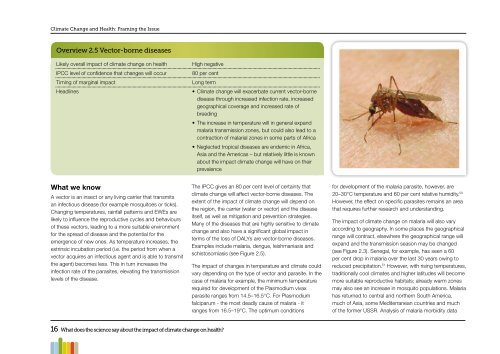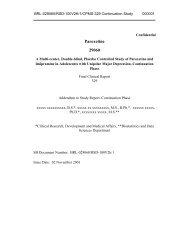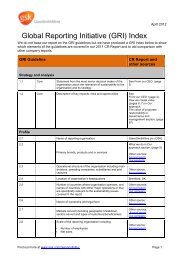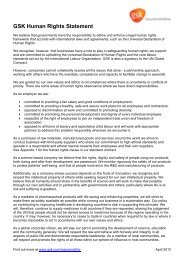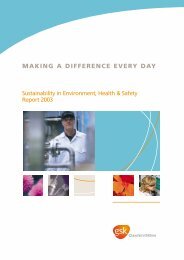Climate Change and Health: Framing the issue
Climate Change and Health: Framing the issue
Climate Change and Health: Framing the issue
Create successful ePaper yourself
Turn your PDF publications into a flip-book with our unique Google optimized e-Paper software.
<strong>Climate</strong> <strong>Change</strong> <strong>and</strong> <strong>Health</strong> <strong>Health</strong>: <strong>Framing</strong> Paper <strong>the</strong> Issue<br />
Overview 2.5 Vector-borne diseases<br />
Likely overall impact of climate change on health High negative<br />
IPCC level of confidence that changes will occur 80 per cent<br />
Timing of marginal impact Long term<br />
Headlines • <strong>Climate</strong> change will exacerbate current vector-borne<br />
disease through increased infection rate, increased<br />
geographical coverage <strong>and</strong> increased rate of<br />
breeding<br />
• The increase in temperature will in general exp<strong>and</strong><br />
malaria transmission zones, but could also lead to a<br />
contraction of malarial zones in some parts of Africa<br />
• Neglected tropical diseases are endemic in Africa,<br />
Asia <strong>and</strong> <strong>the</strong> Americas – but relatively little is known<br />
about <strong>the</strong> impact climate change will have on <strong>the</strong>ir<br />
prevalence<br />
What we know<br />
A vector is an insect or any living carrier that transmits<br />
an infectious disease (for example mosquitoes or ticks).<br />
Changing temperatures, rainfall patterns <strong>and</strong> EWEs are<br />
likely to influence <strong>the</strong> reproductive cycles <strong>and</strong> behaviours<br />
of <strong>the</strong>se vectors, leading to a more suitable environment<br />
for <strong>the</strong> spread of disease <strong>and</strong> <strong>the</strong> potential for <strong>the</strong><br />
emergence of new ones. As temperature increases, <strong>the</strong><br />
extrinsic incubation period (i.e. <strong>the</strong> period from when a<br />
vector acquires an infectious agent <strong>and</strong> is able to transmit<br />
<strong>the</strong> agent) becomes less. This in turn increases <strong>the</strong><br />
infection rate of <strong>the</strong> parasites, elevating <strong>the</strong> transmission<br />
levels of <strong>the</strong> disease.<br />
016Introduction<br />
16 What does <strong>the</strong> science say about <strong>the</strong> impact of climate change on health?<br />
The IPCC gives an 80 per cent level of certainty that<br />
climate change will affect vector-borne diseases. The<br />
extent of <strong>the</strong> impact of climate change will depend on<br />
<strong>the</strong> region, <strong>the</strong> carrier (water or vector) <strong>and</strong> <strong>the</strong> disease<br />
itself, as well as mitigation <strong>and</strong> prevention strategies.<br />
Many of <strong>the</strong> diseases that are highly sensitive to climate<br />
change <strong>and</strong> also have a significant global impact in<br />
terms of <strong>the</strong> loss of DALYs are vector-borne diseases.<br />
Examples include malaria, dengue, leishmaniasis <strong>and</strong><br />
schistosomiasis (see Figure 2.5).<br />
The impact of changes in temperature <strong>and</strong> climate could<br />
vary depending on <strong>the</strong> type of vector <strong>and</strong> parasite. In <strong>the</strong><br />
case of malaria for example, <strong>the</strong> minimum temperature<br />
required for development of <strong>the</strong> Plasmodium vivax<br />
parasite ranges from 14.5–16.5°C. For Plasmodium<br />
falciparum - <strong>the</strong> most deadly cause of malaria - it<br />
ranges from 16.5–19°C. The optimum conditions<br />
for development of <strong>the</strong> malaria parasite, however, are<br />
20–30°C temperature <strong>and</strong> 60 per cent relative humidity. 50<br />
However, <strong>the</strong> effect on specific parasites remains an area<br />
that requires fur<strong>the</strong>r research <strong>and</strong> underst<strong>and</strong>ing.<br />
The impact of climate change on malaria will also vary<br />
according to geography. In some places <strong>the</strong> geographical<br />
range will contract, elsewhere <strong>the</strong> geographical range will<br />
exp<strong>and</strong> <strong>and</strong> <strong>the</strong> transmission season may be changed<br />
(see Figure 2.3). Senegal, for example, has seen a 60<br />
per cent drop in malaria over <strong>the</strong> last 30 years owing to<br />
reduced precipitation. 51 However, with rising temperatures,<br />
traditionally cool climates <strong>and</strong> higher latitudes will become<br />
more suitable reproductive habitats; already warm zones<br />
may also see an increase in mosquito populations. Malaria<br />
has returned to central <strong>and</strong> nor<strong>the</strong>rn South America,<br />
much of Asia, some Mediterranean countries <strong>and</strong> much<br />
of <strong>the</strong> former USSR. Analysis of malaria morbidity data


